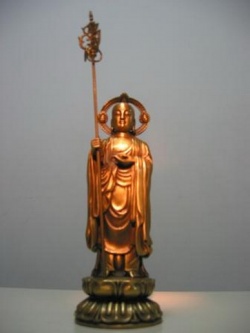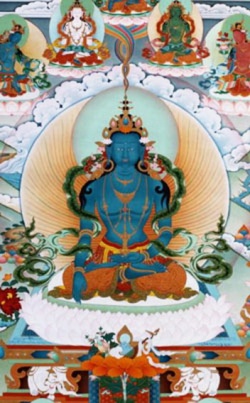Tri-pitaka and twelve divisions
TRI-PITAKA AND TWELVE DIVISIONS
Tripitaka (or Tipitika) is the collection of the teachings of the Buddha over 45 years. It consists of Sutra (the conventional teaching), Vinaya (Disciplinary code) and Abhidhamma (commentaries).
The Tripitaka was compiled and arranged in its present form by the disciples who had immediate contact with Shakyamuni Buddha.
The Buddha had passed away, but the sublime Dharma which he unreservedly bequeathed to humanity still exists in its pristine purity.
Although the Buddha had left no written records of his teachings, his distinguished disciples preserved them by committing to memory and transmitting them orally from generation to generation.
40.1 Brief historical background
Immediately after the final passing away of the Buddha, 500 distinguished Arahats held a convention known as the First Buddhist Council to rehearse the Doctrine taught by the Buddha. Venerable Ananda, who was a faithful attendant of the Buddha and had the special privilege of hearing all the discourses the Buddha ever uttered, recited the Sutra, whilst the Venerable Upali recited the Vinaya, the rules of conduct for the Sangha.
One hundred years after the First Buddhist Council, some disciples saw the need to change certain minor rules. The orthodox Bhiksus said that nothing should be changed while the others insisted on modifying some disciplinary rules (Vinaya). Finally, the formation of different schools of Buddhism germinated after his council. And in the Second Council, only matters pertaining to the Vinaya were discussed and no controversy about the Dharma was reported.
In the 3rd Century B.C. during the time of Emperor Asoka, the Third Council was held to discuss the differences of opinion held by the Sangha community. At this Council the differences were not confined to the Vinaya but were also connected with the Dharma. The Abhidhamma Pitaka was discussed and included at this Council. The Council which was held in Sri Lanka in 80 B.C. is known as the 4th Council under the patronage of the pious King Vattagamini Abbaya. It was at this time in Sri Lanka that the Tripitaka was first committed to writing in Pali language.
40.2 Sutra Pitaka
The Sutra Pitaka (Sutra Pitaka in Sanskrit) consists mainly of discourses delivered by the Buddha himself on various occasions. There were also a few discourses delivered by some of his distinguished disciples (e.g. Sariputta, Ananda, Moggallana) included in it. It is like a book of prescriptions, as the sermons embodied therein were expounded to suit the different occasions and the temperaments of various persons. There may be seemingly contradictory statements, but they should not be misconstrued as they were opportunely uttered by the Buddha to suit a particular purpose.
This Pitaka is divided into five Nikayas or collections, viz.:-
Dlgha Nikaya (Collection of Long Discourses)
Majjhima Nikaya (Collection of Middle-length Discourses)
Samyuita Nikaya (Collection of Kindred Sayings)
Anguttara Nikaya (Collection of Discourses arranged in accordance with number
Khuddaka Nikaya (Smaller Collection)
The fifth is subdivided into fifteen books:-
Khuddaka Patha (Shorter Texts)
Dhammapada (The Way of Truth)
Udana (Heartfelt sayings or Paeons of Joy)
Iti Vuttaka ('Thus said' Discourses)
Sutta Nipata (Collected Discourses)
Vimana Vatthu (Stories of Celestial Mansions)
Peta Vatthu (Stories of Petas)
Theragatha (Psalms of the Brethren
Therigatha (Psalms of the Sisters)
Jataka (Birth Stories)
Niddesa (Expositions)
Patisambhida (Analytical Knowledge)
Apadana (Lives of Saints)
Buddhavamsa (The History of Buddha)
Cariya Pitaka (Modes of Conduct)
40.3 Vinaya Pitaka
The Vinaya Pitaka mainly deals with the rules and regulations of the Order of monks (Bhikhus) and nuns (Bhikhunis). It also gives an account of the life and ministry of the Buddha. Indirectly it reveals some useful information about ancient history, Indian customs, arts, sciences, etc.
For nearly twenty years since his enlightenment, the Buddha did not lay down rules for the control of the Sangha. Later, as the occasion arose, the Buddha promulgated rules for the future discipline of the Sangha.
This Pitaka consists of the following five books:-
Parajika Pali (Major Offences)
Pacittiya Pali (Minor Offences)
Mahavagga Pali (Greater Section)
Cullavagga Pali (Smaller Section]])
Parivara Pali (pitome of the Vinaya)
40.4 Abhidhamma Pitaka
The Abhidhamma (Abhidharma in Sanskrit), also known as Shastra, is the most important and interesting, as it contains the profound philosophy of the Buddha's teaching in contrast to the illuminating but simpler discourses in the Sutra Pitaka.
In the Sutra Pitaka one often finds references to individual, being, etc., but in the Abhidhamma, instead of such conventional terms, we meet with ultimate terms, such as aggregates, mind, matter etc.
In the Abhidhamma everything is analyzed and explained in detail, and as such it is called analytical doctrine (Vibhajja Vada]]).
Four ultimate things (Paramattha) are enumerated in the Abhidhamma. They are Citta (Consciousness), Cetasika (Mental concomitants). Rupa (Matter) and Nibbana.
The so-called being is microscopically analyzed and its component parts are minutely described. Finally the ultimate goal and the method to achieve it is explained with all necessary details.
The Abhidhamma Pitaka is composed of the following works:
Dhamma-Sangani (Enumeration of Phenomena)
Vibhanaga (The Book of the Treatises)
Ikatha Vatthu (Point of Controversy)
Puggala Pannatti (Description of Individuals)
Dhatu Katha (Discussion with reference to Elements)
Yamaka (The Book of Pairs)
Patthana (The Book of Relations)
40.5 Twelve Divisions of Buddhist Canons
The content of Buddhist canons is divided into twelve divisions, categorized by the types of forms of literature (i.e., Sutra, Geya and Gatha) and the context (i.e., all other nine divisions). It is known as the Twelve Divisions.
Sutra (Sutta in Pali) - These are the short, medium, and long discourses expounded by the Buddha on various occasions. The whole Vinaya Pitaka is also included in this respect.
Geya (Geyya in Pali) - i.e., the metrical pieces. These are discourses/proses mixed with Gathas or verses.
Gatha - i.e., verses, chants or poems. These include verses formed in the Dharmapada, etc., and those isolated verses which are not classified amongst the Sutra.
Nidana - i.e., the causes and conditions of the Buddha's teachings.
Itivrttaka - i.e., the sutras in which the Buddhas tell of the deeds of their disciples and others in previous lives.
Jataka - i.e., stories of the former lives of Buddhas. These are the 547 birth-stories.
Abbhuta-dharma - i.e., miracles, etc. These are the few discourses that deal with wonderful and inconceivable powers of the Buddhas.
Avadana - i.e., parables, metaphors. Illustrations are used to facilitate the human beings to understand the profound meanings of the Buddhist Dharma.
Upadesa - i.e., dogmatic treatises. The discourse and discussions by questions and answers regarding the Buddhist doctrines. It is a synonym for Abhidharma Pitaka.
Udana - i.e., impromptu or unsolicited addresses. The Buddha speaks voluntarily and not in reply to questions or appeals, e.g., the Amitabha Sutra.
Vaipulya - i.e., interpretation by elaboration or deeper explanation of the doctrines. It is the broad school or wider teachings, in contrast with the "narrow" school. The term covers the whole of the specifically Mahayana sutras. The Sutras are also known as the scriptures of measureless meaning, i.e., infinite and universalistic.
Vyakarana (Veyyakarama in Pali) - i.e. prophecies, prediction by the Buddha of the future attainment of Buddhahood by his disciples.
40.6 Nine Divisions of Buddhist Canons
The term is generally referred to Hinayana. There are only nine divisions excluding Udana, Vaipulya and Vyakarana.
However, there is also a Mahayana division of nine of the Twelve Divisions, i.e., all except Nidana, Avadana and Upadesa.







